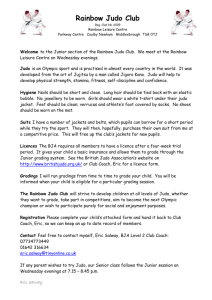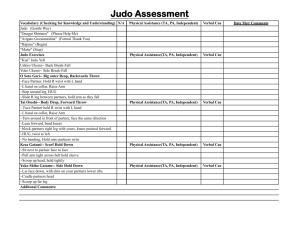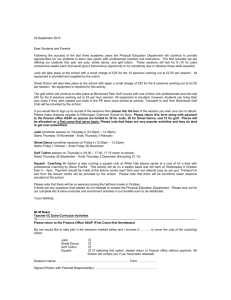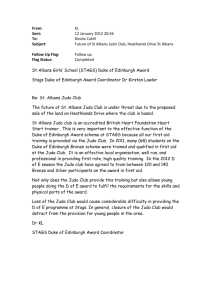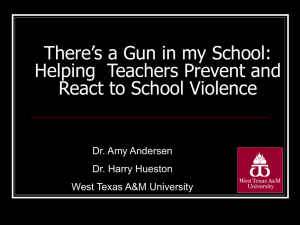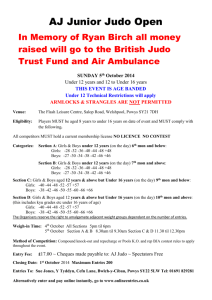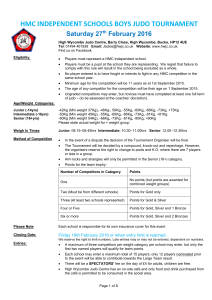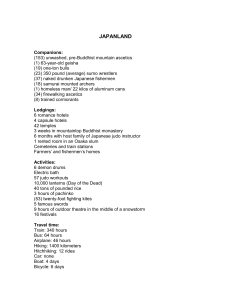score - Ruidera - Universidad de Castilla
advertisement
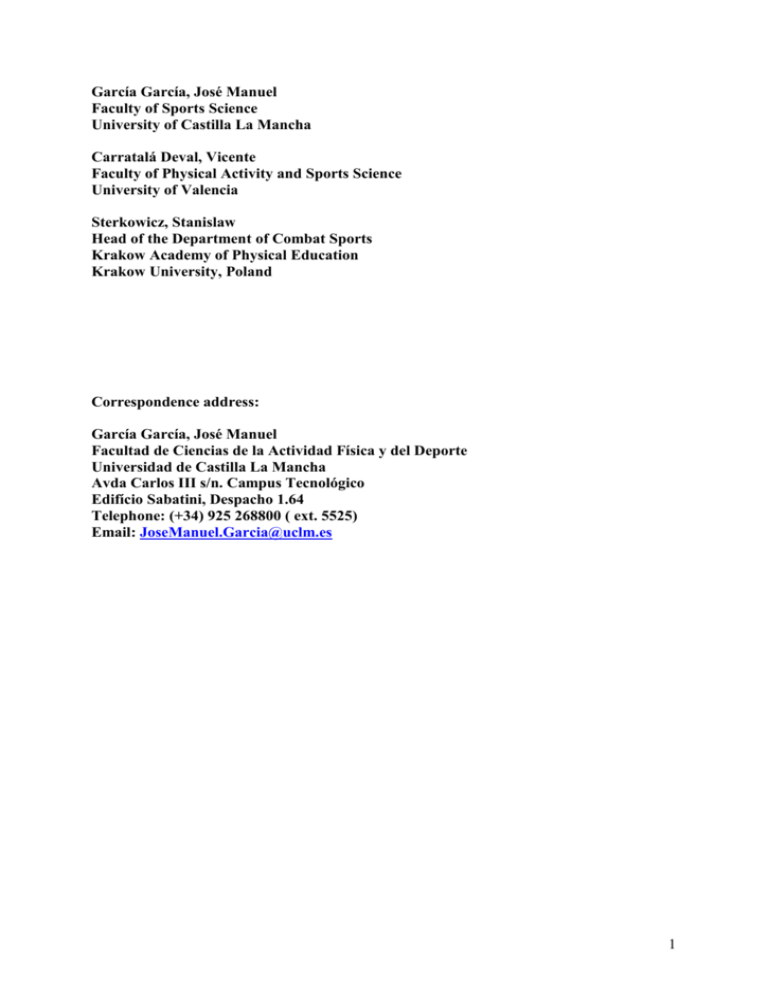
García García, José Manuel Faculty of Sports Science University of Castilla La Mancha Carratalá Deval, Vicente Faculty of Physical Activity and Sports Science University of Valencia Sterkowicz, Stanislaw Head of the Department of Combat Sports Krakow Academy of Physical Education Krakow University, Poland Correspondence address: García García, José Manuel Facultad de Ciencias de la Actividad Física y del Deporte Universidad de Castilla La Mancha Avda Carlos III s/n. Campus Tecnológico Edifício Sabatini, Despacho 1.64 Telephone: (+34) 925 268800 ( ext. 5525) Email: JoseManuel.Garcia@uclm.es 1 A STUDY OF THE DIFFICULTIES INVOLVED IN INTRODUCING YOUNG CHILDREN TO JUDO TECHNIQUES: A PROPOSED TEACHING PROGRAMME ABSTRACT The process of teaching-learning judo has developed from a single competition-oriented focus towards the diversification of goals that aim to provide a broader sense of physical activity, ranging from educational to health-related aspects and including, of course, sporting competition. With this in mind we sought the opinion of active judo teachers with regard to the traditional teaching of the sport. We received almost a thousand responses from teachers, who felt that the order in which techniques are taught ought to be changed to take the following aspects into consideration: the safety of participants, ease of execution and motivation. Key words: judo, teaching-learning INTRODUCTION The age at which people take up judo and the level of participation are important variables that need to be considered when adapting teaching content. This study focuses on the six to twelve-year-olds, a stage at which nearly 80% of participants take up the sport. According to Carratalá[1]1, Spanish children start learning judo between the ages of four and eight, accounting for 73% of the total number of people beginning judo lessons. With 22.9% and 17.7% respectively, six and five-year-olds account for the highest numbers of children taking up judo, followed by four-year-olds with 16% and eight-year-olds with 11.3 %. Within the age ranges referred to, seven-year-olds provided the lowest proportion of beginners at 8.7 %. As Table 1 shows, from the age of nine onwards there is a drop in the number of people who begin judo lessons, with figures gradually descending from the age of ten through to fourteen-year-olds, only 0.9 % of whom start lessons in the sport. Table 1. Judo beginners – age groups Age Actual % Accumulated % 16.0 16.0 4 17.7 33.8 5 22.9 56.7 6 8.7 65.4 7 11.3 76.6 8 6.1 82.7 9 7.8 90.5 10 4.3 94.8 11 1.7 96.5 12 2.6 99.1 13 0.9 100 14 Authors such as Geesink2, Gleeson3, Sacripanti4, Kolychkyne5 and Dopico and Iglesias6 have suggested criteria for categorising judo techniques. However, the best known principles, which we shall refer to here, were published by the founder of judo, Jigoro Kano (1860-1938), in 1889. These writings have been updated by the Kodokan in Tokyo and are used as a guide by the various national federations 7. The Go-Kyo “is a theoretical reflection on how techniques should be organised so that they may be learnt according to a rational process”8. Many contributions have emerged since publication of the very first Go-Kyo, written in 1895, and the one put forward by the Kodokan in 1920, which is applied in most countries today, including Spain. These contributions set out to adapt the difficulties involved in teaching judo to social change and the gradual rise in the number of young participants. The most notable of these from a historical perspective was written by the judo master Mikonosuke Kawaishi (1899-1969)9, who based his work on the proposals made by Gunji Koizumi (1865-1965) in order to westernise the teaching of judo by proposing several levels of difficulty corresponding with the colour of belt worn by the participant. In Spain, authors such as Cecchini10, González11, García12, Gaspar13, Amador14, Carratalá15, Dopico, Iglesias and Romay16, various authors17 and Castarlenas et al.18 have proposed interesting ideas based on the general perspective of learning judo. Others, such as Carratalá 19202122, Muzas et al.23, García24 and Sterkowicz and García25, have made specific proposals on the contents of judo programmes for children of young ages. These are just some of the authors who have made contributions designed to improve the process of teaching judo. This particular work focuses on the experiences of judo teachers who work with children in clubs and schools on an everyday basis and its aim is to provide an accurate snapshot of the point at which these 2 youngsters encounter significant difficulties in learning techniques as well as an assessment of the timing and sequencing of content. Objectives This study aims to analyse the difficulty in performing the 15 techniques that make up the black belt (1st Dan) programme in Spain, the purpose being to establish a sequential order determined by the level of difficulty, thus enabling us to create a teaching programme more suited to the abilities of the participants. MATERIAL AND METHODS Sampling The study was carried out in 19 countries with a total of 911 teachers, all of whom continue to give lessons and possess at least a 1st Dan black belt. Instrument The criteria used as a reference in the evaluation of each of the techniques analysed in the study were created in accordance with the general principles of these techniques and the level of difficulty in applying them. The criteria are as follows: the degree of difficulty with which tori may achieve posture control; maintaining and applying balance (tori) and imbalance (uke); ease in adjusting technical actions in relation to space and time; the level of difficulty involved in achieving intersegmentary coordination in the execution of each of the techniques. Two other parameters that were considered were the degree of difficulty involved in applying basic pulling and pushing actions in accordance with the direction of the technique and their subsequent control following the throw; and increased safety and preparation for taking a fall by uke. Following creation of the instrument the questionnaire was applied. This involved use of a Likert scale to generate responses to six aspects of each of the aforementioned techniques. Respondents in complete agreement with the statement describing each aspect gave it a maximum value of five, while those in complete disagreement gave it a minimum value of one. The aspects were as follows: 1. Ease with which tori may achieve balance and uke imbalance 2. Ease with which tori may achieve posture control 3. Ease in adjusting to space-time (precision) 4. Ease in achieving intersegmentary coordination 5. Ease in achieving correct direction in pushing and pulling actions 6. Ease with which uke achieves ukemi (falling without the risk of an injury) Procedure The instrument was applied in two different ways. Firstly, head researchers in each country coordinated interviews with teachers attending courses, conferences and training events held in Spain, Portugal, Brazil and Poland. At the same time the questionnaire was posted, along with the relevant instructions, on the website www.egroups.judoeuropa-nano.yahoo.com (now inactive). The response was most impressive and though participants had the option of responding anonymously, over 80% put their names to their answers. The SPSS 12.0 statistics program was used to carry out factor, descriptive and inferential analysis of the study variables. RESULTS There is no reason why the results obtained with regard to the difficulty of learning and teaching the techniques should correspond with the order in which they are taught. Other factors such as the type of ukemi that uke has to perform also come into play in determining this order. They can, however, provide important data in terms of listing the level and ease with which young children learn these techniques. Table 2 details the order in which respondents categorised the techniques in terms of difficulty by rating the six aspects. The highest possible score was 30 points (five points for each of the six aspects). As can be seen, the most highly valued were the Koshi-waza techniques: O-goshi and Koshi-guruma, both of which require the support of both feet and offer an easily controllable ukemi. Okuri-ashi-barai and Tomoe nague were regarded as the most difficult to perform, as both are difficult for uke to control when executing kake and also present problems for tori in terms of posture control. The table is provided below along with the average score in addition to the standard margin of error. Table 2. Mean results for each technique TECHNIQUE SCORE RANKING 3 O GOSHI KOSHI GURUMA O SOTO GARI TAI OTOSHI O UCHI GARI KO UCHI GARI KO SOTO GAKE HARAI GOSHI IPPON SEOI NAGUE UKI GOSHI SASAE TSURI KOMI ASHI TSURI KOMI GOSHI DE ASHI BARAI KATA GURUMA HIZA GURUMA OKURI ASHI BARAI TOMOE NAGUE 23.21 ± 2.72 19.54 ± 2.69 19.34 ± 2.12 18.99 ± 3.07 18.31 ± 3.24 17.55 ± 3.99 17.45 ± 3.17 17.13 ± 1.15 16.09 ± 1.98 16.02 ± 3.01 14.96 ± 2.87 13.92 ± 2.86 13.23 ± 3.11 12.23 ± 3.07 11.93 ± 1.46 10.74 ± 2.11 08.15 ± 3.38 1 2 3 4 5 6 7 8 9 10 11 12 13 14 15 16 17 As regards the level of difficulty in terms of execution, teachers identified the techniques detailed in Table 3 as the ones that corresponded most closely to the criteria set out in each aspect. Table 3. Breakdown of techniques according to ease with which they are performed Aspect Techniques that are easiest to Techniques that are hardest to perform perform Ease with which tori may achieve O GOSHI, KOSHI GURUMA and TOMOE NAGUE and HIZA balance and uke imbalance: TAI OTOSHI GURUMA Ease with which tori may achieve O GOSHI, O SOTO GARI and KO HIZA GURUMA and KATA posture control: SOTO GAKE GURUMA Ease in adjusting to space-time O GOSHI, O SOTO GARI and DE ASHI BARAI and OKURI (precision): KOSHI GURUMA ASHI BARAI. Ease in achieving intersegmentary KO SOTO GAKE, O GOSHI and TSURI KOMI GOSHI, TOMOE coordination: KOSHI GURUMA NAGUE Ease in achieving correct direction in O GOSHI, TAI OTOSHI and KATA GURUMA and O UCHI pushing and pulling actions: KOSHI GURUMA GARI Ease with which uke achieves ukemi O SOTO GARI, DE ASHI BARAI, TOMOE NAGUE, KATA (falling without the risk of an O UCHI GARI GURUMA injury): The section that posed the most problems for teachers was “Ease in achieving correct direction in pushing and pulling actions”, while the aspect that proved least problematic in terms of execution was “Intersegmentary coordination”. In order to draw up a judo programme for children we needed to find out the importance that teachers gave to each of the aspects. This is detailed in Table 4 below. Table 4. Ease in achieving correct direction in pushing and pulling actions Rating given to each aspect 6 5 4 3 2 Difficulty of uke achieving ukemi 65.97 32.38 1.64 Intersegmentary coordination 21.40 53.45 20.41 4.72 Tori posture control 10.55 9.11 59.60 17.56 3.18 Tori balance-imbalance 2.08 3.95 16.79 44.02 32.82 Space-time adjustment (precision) 0.87 1.56 27.45 50.83 Problems in achieving pushing and pulling 0.24 6.25 13.17 direction 100% 100% 100% 100% 100% 1 0.33 18.22 81.45 100% As Table 4 shows, with regard to the creation of a teaching programme, the teachers surveyed take into consideration the possible risk of the judoka suffering injury when they are thrown, in other words, the level of difficulty in executing and receiving ukemi, with priority being given to safety during the course of the fall. They also consider development of intersegmentary coordination to be important. 4 DISCUSSION In the view of teachers, the aspect that poses the greatest difficulty to children of these ages is the adjustment to space and time. The De ashi harai and Okuri ashi harai throws present an added difficulty as they introduce the concept of precision. However, this is not a reason in itself for young children not to be taught these techniques as learning them also helps them to learn Yoko ukemi. These actions should be taught by modifying part of their structure (uke with one knee on the ground) in order to make it easier for tori to achieve stability and execute the throw. The same is true with Sasae tsuri komi ashi and Hiza guruma, both of which are difficult techniques even for an experienced judoka, but which should be taught to young children as they can help them learn Zempo kaiten ukemi. In assessing the six aspects teachers based their contributions on two considerations that are fundamental to how teaching of the techniques should be structured, namely the level of difficulty in their execution, and the most important aspects to be taken into consideration in the creation of a programme for young children. These findings have some similarities with the premises of the methodological programme of the French Judo Federation, the proposal made by Carratalá and Carratalá26 and the one recently put together by the Galician Judo Federation27. In perhaps taking a more traditional outlook, Nayima 28 states that judo has survived to this day without any problem due to its fundamental concepts and to the fact that it is understood as a system of learning and training, a system that, as the results of this study reveal, must evolve and adapt to modern society’s expectations by searching for alternatives in the way the sport is taught. CONCLUSIONS Based on the results, we can conclude that a new methodological proposal for teaching children of these ages should be put forward, the aim being to encourage them to learn the sport and to help build a stronger relationship between judo and schools, where it is little used by PE teachers and little known by most children. The inclusion of judo and combat sports in school PE syllabuses would provide a new focus in the acquiring of skills and capabilities, thereby contributing to motor development and helping children become independent and responsible and to master motor skills29. This development must be shaped by actions and techniques that enable the classmate to be thrown more easily and which are supported by teaching actions based on the concepts of safe execution and the stability (balance) of the thrower. The aim in doing so is to create a methodology setting out a learning process that follows a logical order in the application of content based on the level of difficulty. Proposal for the organisation of programme contents We propose the application of two criteria in organising teaching techniques. The first places an emphasis on the safety of uke and the second takes into consideration the ease of executing the actions. The aim here is that tori should always have two points of support in executing the technique and that the thrower should be able to control the fall of their opponent with ease. A second skills level would complement the skills acquired beforehand and would include a progression from techniques that have already been learnt to the acquisition of new ones. These aspects mirror those put forward by the FFJDA (1989) 30, which stated that content should be structured in line with the ease with which it can be executed by students engaged in the learning process and the safety of the fall resulting from the application of the technique. It is very important that the teaching environment offers young learners complete physical safety and emotional security. The emotional security generated by the relationship built up within a group of learners is also a factor in learning. This particular concept should be borne in mind in teaching falls, as security helps build confidence in the execution of ukemi and thus helps the defender overcome their fear of being thrown, which is a key element to future progress. The thrower must ensure that conditions are right for a safe fall as the role of the thrower and the thrown are one and the same 31. Table 5 details the proposed programme for teaching young children judo foot techniques, broken down according to ages and belt colours. Table 5. Proposed programme, taking difficulty of execution and age of learners into consideration AGE BELT COLOUR PROGRAMME 6 WHITE-YELLOW MOBILITY/JUDO + UKEMI O SOTO GARI (OTOSHI) O-GOSHI 7 YELLOW DE ASHI BARAI KO SOTO GARI (GAKE) O UCHI GARI 8 YELLOW-ORANGE KOSHI GURUMA SASAE TSURI K. ASHI 5 9 ORANGE 10 ORANGE-GREEN 11 GREEN 12 GREEN-BLUE 13 BLUE 14 BLUE-BROWN 15 BROWN OKURI A. BAR (LINEAR) KO UCHI GARI SEOI NAGUE HIZA GURUMA OKURI A.B. (ROTATION) HARAI GOSHI TSURI GOSHI KATA GURUMA UKI WAZA LEVEL II GROUP A** UCHI MATA TSURI KOMI GOSHI TOMOE NAGUE URA NAGUE LEVEL II GROUP B** HANE GOSHI (ASHI G) USHIRO GOSHI UTSURI GOSHI YOKO GAKE (GURUMA) LEVEL II GROUP C** ** Development of techniques in relation to age and the motor capabilities of the judoka, opportunities, combinations, counterattacks, etc. This proposal is adapted to the content and structure of judo in Spain. We should point out that the minimum age for holding a black belt in Spain is 16, whereas in other countries it is 18. We have not set objectives for learners below the age of six even though there are many centres where children as young as four are taking up the sport. Along with the age at which learners can be awarded a black belt in other countries, this is an aspect that should be taken into account when making suitable adjustments in each area of application. Bibliography: Adams N. Los agarres. Barcelona: Paidotribo; 1992. Babic I. Judo za mlade. Slovenije: Slovenska Bystrica; 2001. Bonfranchi B, Klocke U. Wirmachen Judo. Falken Verlag GmbH; 1978. Brousse M, Matsumoto D. Judo: A Sport and a Way of Life. Seoul: IJF; 1999. Federatión Francaise de Judo. Méthode française d’enseignement du judo-jujitsu. Paris; 1987. García JM, Del Valle S, La importancia de los juegos en la enseñanza del judo. Barcelona: Paidotribo; 2006. Pohler R. Iniciación al judo. Del cinturón blanco al verde. Las primeras competiciones. Barcelona: Hispano Europea; 1998. 1 Carratalá V. La enseñanza del judo en edades tempranas. In: Camarero S et al. La actividad deportiva en el ámbito escolar. Valencia: Promolibro; 1997. p. 245-267. 2 Geesink A. Mi Judo. Mexico: Diana; 1967. 3 Gleeson GR. Judo para occidentales. Barcelona: Hispano-Europea; 1977. 4 Sacripanti A. Biomeccanica del Judo. Roma: Mediterranée; 1989. 5 Kolychkine A. Judo. Nueva didáctica. Colección deporte. Barcelona: Paidotribo; 1989. 6 Dopico J, Iglesias E. Clasificación y organización de los contenidos de enseñanza específicos en judo para la intervención en la iniciación. In: El judo y las ciencias de la educación física y el deporte. Vitoria: Instituto Vasco de Educación Física; 1997. 7 Carratalá V. Iniciación al judo. Guía Praxis para el profesorado de ESO Educación Física. Contenidos, Actividades y Recursos. Barcelona: Editorial Praxis; 2003. 8 Kano J. Kodokan Judo. Tokyo: Kodansha International; 1986. 6 9 Kawaishi M. Mi método de Judo. Barcelona: Bruguera; 1964. Cechini JA. El judo y su razón kinantropológica. Gijón: GH Editores; 1989. 11 González A. Estudio cualitativo y cuantitativo de las técnicas de judo utilizadas en relación con el sexo, peso y edad de los competidores. Doctoral thesis. Madrid: Universidad Complutense (not published); 1990. 12 García, JM. Preparación física. Taira et al. Judo II. Madrid: Comité Olímpico Español; 1992. p. 401-462. 13 Gaspar VM. El libro del judoka. Bilbao: Victor Manuel Gaspar Cortina; 1996. 14 Amador F. Fases de la iniciación a la enseñanza de los deportes de lucha. In: Amador F, Castro U, Àlamo JM, editors. Luchas, deportes de combate y juegos tradicionales. Madrid: Gymnos; 1997. p. 365-385. 15 Carratalá V. Los juegos y deportes de lucha en el marco de la educación física escolar. In: Villamon M, editor. La educación física en el curriculum de primaria. Valencia: Conselleria de Cultura, Educació i Ciència; 1998. p. 269-316. 16 Dopico J, Iglesias E, Romay B. Judo habilidades específicas. Xunta de Galicia, Secretaría Xeral para o Deporte: Ediciones Lea; 1998. 17 Various Authors. Introducción al judo. Hispano Europea; 1999. 18 Castarlenas et al. El judo en la educación física escolar. Hispano Europea; 2002. 19 Carratalá V. Factores personales y sociales que influyen en la práctica del judo. In: Ayora D, Campos J, Devís J, Escartí A. Aportaciones al estudio de la actividad física y el deporte. Valencia: IVEF; 1997. p. 201-212. 20 Carratalá V, Carratalá E. La actividad física y deportiva extraescolar en los centros educativos. Judo. Ministerio de Educación Cultura y Deporte: Consejo Superior de Deportes; 2000. 21 (Idem) Carratalá V. Iniciación al judo. Guía Praxis para le profesorado de ESO Educación Física. Contenidos, Actividades y Recursos.Barcelona: Editorial Praxis; 2003. 22 Carratalá V et al. La iniciación deportiva en los deportes de lucha. In: Pablos, Carratalá V. La Actividad Física en la Adolescencia. Valencia: Ajuntament de Valencia; 2004. p. 185-216. 23 Muzas M, De Frutos JL, Galán E, Soria F. Método didáctico de Judo infantil. Vigo: Federación Gallega de Judo, Excma Diputación de Pontevedra; 2003. 24 García JM. Análisis diferencial entre los paradigmas experto-novato en el contexto del alto rendimiento deportivo en judo. Doctoral thesis. University of Castilla La Mancha; 2004. 25 Sterkowicz S, Garcia JM. Current problems of Judo coach education. Wychowanie Fizyczne i Sport. Vol 46; Supplement No. 1; Part 1; June 2002. Poland; 2002. p. 612-613. 26 (Idem) Carratalá V, Carratalá E. La actividad física y deportiva extraescolar en los centros educativos. Judo. Ministerio de Educación Cultura y Deporte: Consejo Superior de Deportes; 2000. 27 Muzas M, De Frutos JL, Galán E, Soria F. Método didáctico de Judo infantil. Vigo: Federación Gallega de Judo, Excma Diputación de Pontevedra; 2003. 28 Nayima M. The Way to Black Belt. 2000. Available from: <http://www.topjudo/coaches/nayima3.htm> 29 (Idem) Carratalá V, Carratalá E. La actividad física y deportiva extraescolar en los centros educativos. Judo. Ministerio de Educación Cultura y Deporte: Consejo Superior de Deportes; 2000. 30 Falta la referencia. 31 (Idem) Carratalá V. Iniciación al judo. Guía Praxis para le profesorado de ESO Educación Física. Contenidos, Actividades y Recursos.Barcelona: Editorial Praxis; 2003. 10 7
